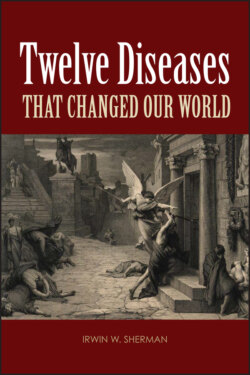Читать книгу Twelve Diseases that Changed Our World - Irwin W. Sherman - Страница 4
Preface
ОглавлениеThe literature on the impact of disease on history is large. It chronicles how illness has affected Western civilizations: in the 14th century plague broke the Malthusian stalemate and provided the impetus to restructure European societies; during the past two centuries genetic diseases altered the fates of the British, Spanish, and Russian royal families and contributed to the rise of Lenin, Franco, and Hitler; in the last 100 years we have witnessed how increased opportunities for disease transmission have decimated populations, created panic, and fostered discrimination. We continue to be painfully aware of the power a disease can wield in effecting social and political changes on a grand scale and how it can reveal and exacerbate social tensions. In the past, disease played a role in colonial expansion in the Americas and Africa and, through demographic pressure and starvation, forced a mass migration of the Irish people; tomorrow in different places and in different ways, another disease may do the same.
Historical perspectives of disease can be valuable for a better understanding of how we, and our forebears, survived the onslaught of “plagues” and how we might avoid some of their consequences: confrontations between immigrants and nativists, discrimination against those with different lifestyles, and the social and political disruptions due to incapacitation and death. Of equal value, and much needed, is an examination of the attempts to control disease and how it was possible to improve the public health. In short, this book is about the lessons we have or should have learned from our past encounters with unanticipated outbreaks of disease and how such understanding can be put to use when future outbreaks occur.
The recent SARS and AIDS pandemics clearly show that our lives, as well as the political and economic fortunes of the developed world and emerging nations, can be influenced by the appearance of a contagious disease. In 2004, alarm bells went off as avian influenza spread across the globe, killing millions of domestic fowl and 113 people. The public asked what measures would be needed to stop its spread so that another 1918 to 1920 flu pandemic, which killed tens of millions of people, would not occur. In 2006 cholera swept through West Africa, striking 20,000 people, and in the United States mumps—no longer thought to be a threat because of childhood vaccination—broke out in Iowa and quickly spread to neighboring states, affecting 1,000 people.
These unanticipated epidemics provoke questions. What is needed to curtail the transmission of a disease? What will it take to contain a disease so that protective measures can be instituted? These questions, perplexing and complex, need answers. To simply catalog past diseases and tell of their historic consequences would not be of lasting value to the general public. Rather, it was my feeling that the answers to how we might deal with “coming plagues” could be better obtained by an examination of how past encounters with disease allowed for better control and improved health.
Our world has experienced so many diseases that it would be pointless to deal with all of them. In fact, it would be a nearly impossible task, and, if achieved, it would be numbing to read. Instead, I have selected a dozen diseases that have shaped our history and illuminated the paths taken in finding measures to control them. Porphyria and hemophilia (chapter 1) influenced the political fortunes of England, Spain, Germany, Russia, and the United States; late blight (chapter 2) spawned a wave of immigration that changed the politics of the United States; cholera (chapter 3) stimulated sanitary measures, promoted nursing, and led to the discovery of oral rehydration therapy; smallpox (chapter 4) led to a vaccine that ultimately eradicated the disease; plague (chapter 5) promoted quarantine measures and attenuated vaccines were the result of outbreaks of tuberculosis (chapter 6); syphilis (chapter 7) provided the impetus for cure through chemotherapy; and malaria and yellow fever (chapters 8 and 9) provided the basis for vector control. However, despite these successes, two pandemics—influenza (chapter 10) and HIV/AIDS (chapter 11)—continue to elude control. In this book I try to answer why this is so.
The message of this book is simple: understanding past outbreaks of disease can better prepare us for those in our future. The twelve diseases chosen have influenced the way we look at sickness and show how they resulted in public health measures and other interventions to stem the spread of that disease and others. To eliminate the fear and confusion surrounding “coming plagues,” I describe the ways we have succeeded in bringing certain diseases under control and, in other cases, our failures. My purpose in writing this book for the general reader is to show that despite the challenges which an unanticipated illness may place before us, the future is not without hope or remedy.
